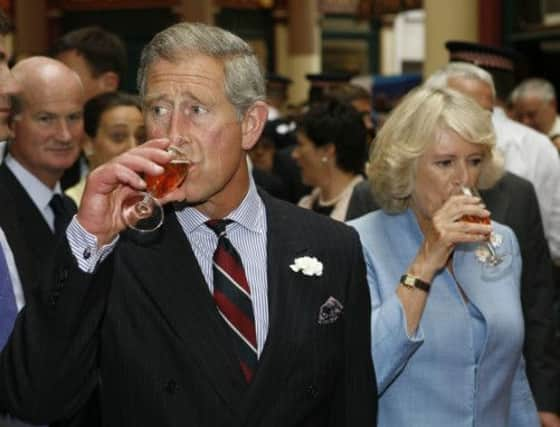The wine list: Camel Valley


“We bought a farm in Cornwall back in 1982, because that was the cheapest place to buy one,” says Suffolk-born Bob Lindo. “We never bought it with the intention of planting vines, we just intended to raise livestock,” he tells me.
After training as an engineer and working as an RAF pilot, a mid-air collision in his 30s left Bob with his back broken in three places. His spinal injuries convinced him and his wife Annie to look for a different lifestyle. The 82-acre farm near Bodmin was remote and rundown, but they decided to make a go of it and they renovated it.
Advertisement
Hide AdAdvertisement
Hide Ad“Each year we would see the grass on the slopes in front of our house turn brown in the summer and we wondered whether it might be possible to ripen grapes here,” says Bob. “We planted our first vines in 1989 just for fun. Our neighbours thought we were mad digging 8,000 holes to put vines in, but the first seyval blanc and reichensteiner vines flourished on the ancient slate soils,” he says.
To learn the basics, Bob worked at a vineyard in Germany and attended various courses, but the rest he and Annie learned from first-hand experience. He admits they made every mistake in the book.
“We literally did everything by hand ourselves from planting, pruning, picking, winemaking and bottling to selling the wines – it was hard work,” says Bob.
“When we started making sparkling wines, we didn’t have the money for sophisticated equipment, with only a small farming grant to buy a press,” he says. He rewired an old freezer to help him freeze the yeasts in the sparkling wine bottles after second fermentation, used a sheep’s syringe to test fizz pressures and old pliers to attach the wire over corks.
Today 75 per cent of Camel Valley’s production is sparkling and the winery is as impressive as any – with a new press, fermenting vats, gyro-palettes to help riddling the yeasts to the necks of the bottles and even his own disgorging and bottling machine (“which cost more than the farm”). All are solar-powered.
Growing vines is never easy. Wherever you are in the world, there are hazards. In Cornwall, Bob’s biggest pests are the badgers and birds which love to eat his grapes.
Frost is also a threat. In the early days, he and Annie would stay up all night trying everything from lighting fires to spraying the vines to protect the buds, but it just made them cross and tired from lack of sleep – and didn’t really help the vines much.
Last year’s vintage was a washout for English winemakers. The Lindos only made 20,000 bottles. This year looks more promising: Bob reckons the 2013 harvest will be mid-October and hopes to make 80,000 to 100,000 bottles of a fine English vintage.
Advertisement
Hide AdAdvertisement
Hide AdBob’s son Sam, a maths graduate, is now a winemaker. Heading for a career in the city, he decided he preferred the idea of running the family farm. He trained as a winemaker in New Zealand with Kim Crawford and returned with fresh ideas, introducing a cold ferment regime.
He has won UK Winemaker of the Year three times with trophies and awards now flooding in to Camel Valley for its fizz – which is even exported to Japan and Korea. Camel Valley is the biggest of three Cornish vineyards (Bosue and Knightor vineyards are on the south coast near St Austell).
Judging from the quality of its sparkling wine compared to the still wines, I reckon this is where it will expand, but Bob emphasises that despite using the same pinot noir and chardonnay grapes as in champagne, the same traditional methods and even winning medals over Roederer and Bollinger – Camel Valley is not the same as champagne.
“We are not trying to be looky-likeys, we want to make something distinctively different from champagne,” says Bob. “We want to emphasise the floral aromas and delicate flavours that we get in Britain. That is why I like using grapes like seyval blanc which grow so well here.”
Camel Valley Vineyards (01208 77959, www.camelvalley.com)
Our recommendations
SPARKLING
CORNWALL BRUT 2011 (£22.95-£24.95, Waitrose; www.camelvalley.com)
After a walk on a windswept beach, there is nothing better than this delicate floral fizz made from seyval blanc, reichensteiner and a little chardonnay with 18 months lees ageing: it tastes lighter than champagne and literally smells of an overgrown English hedgerow.
CORNWALL BRUT ROSÉ 2011 (£26.95, www.camelvalley.com)
A little more depth and complexity of fruit in this pale pink strawberry toned fizz. Made from the pinot noir grape.
WHITE PINOT NOIR SPARKLING 2010 (£29.95, Waitrose; www.camelvalley.com)
Advertisement
Hide AdAdvertisement
Hide AdMy clear favourite in the line-up: lovely citric fruits, sweet undertones, long succulent length made from pinot noir: Lindo’s best. STAR BUY
ANNIE’S ANNIVERSARY BRUT 2010 (£24.95, www.camelvalley.com)
Made in honour of Annie Lindo by her son to commemorate her 100,000th seyval blanc vine pruned in this single vineyard: one of the few vineyards in the world exclusively tended by one person. A floral smooth tribute to her hard graft.
STILL
BACCHUS DRY 2012 (£12.95, www.camelvalley.com)
Light, soft, fragrant, hedgerow-scented with a crisp dry finish – perfect for quaffing with grilled mackerel at a beach barbecue.
PINOT NOIR ROSÉ 2012 (£11.95, www.camelvalley.com; £13.52, reduced from £15.90, sold as English Rosé in Fortnum & Mason)
Another delicate, dry, very quaffable aperitif-style rosé made from pinot noir and the hardy red German dornfelder grape; sold in Fortnums in hampers.
Taste 13 wines from islands across the world at Rose’s Island Wine Masterclass on Wednesday 18 September, £35, Edinburgh, www.rosemurraybrown.com